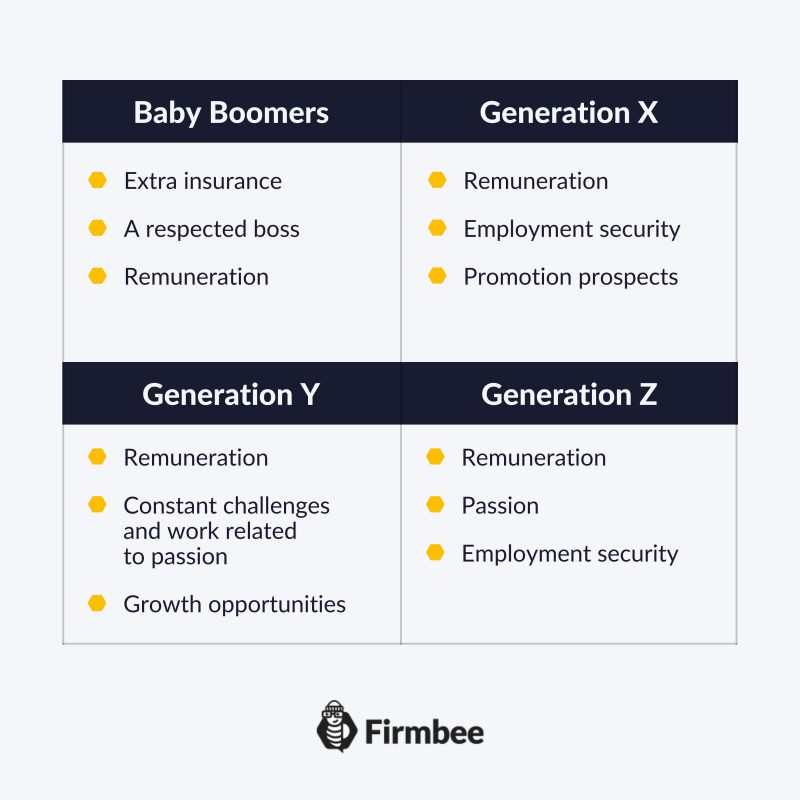The labor market is a place that brings together all generations of workers in a unique way. Most companies employ pre-retired, middle-aged and young people who are at the beginning of their careers. Generational issues in the workplace are a challenge for modern organizations because of the diversity of values and motivations determined by age and social status. How to bridge the generation gap in the workplace? What are the main generations of employees at work? Read our article to find out.
Bridging the generation gap in the workplace – table of contents:
Different generations in the workplace
In the 21st century, due to digital transformation, generational differences have become more visible than ever. New technologies have divided generations of workers on the basis of their ability to use them and their openness to technical innovations. In order to bridge the generation gap, break down barriers and create an organizational culture based on mutual respect, it is important to know the expectations and motivations of employees from each generation.
The oldest generation of employees are the so-called baby boomers. These are usually people who have already retired or are bound to retire, but are still professionally active. Baby boomers stay with one employer for several years as they are extremely loyal and attached to the company.
Generation X (baby busters) is currently dominating the labor market. These are people born between 1965 and 1979 who are attached to traditional interpersonal contacts. They sometimes cannot find their way in the digital reality and do not know where they are headed.
Generation Y (millennials, digital generation) are employees born between 1980 and 1996. Raised on video games, and shaped by Google, they are resistant to authority figures. They tend to be well-educated workers who are fluent in foreign languages and have high expectations.
Generation Z (post-millennials) are very young people born after 1995. The Internet is a dominant value for them, and new technologies have a big impact on their lives. They were born in the era of smartphones and computers, so they perform well in e-marketing and the IT industry.

Generation gap in the workplace
Intergenerational conflicts are common in the professional environment. Older employees get annoyed by the boorishness and arrogance of young people, while young workers do not like to be lectured by older colleagues. Each generation has the right to its own values and opinions, and they do not have to be the same.
The essence is mutual respect and understanding. The role of a manager is to bridge all these differences and use them to build a harmonious, loyal and effective team. In order to do this, it is necessary to diagnose the differences in the most important aspects related to professional life.
The first one concerns the approach to work and maintaining a good work-life balance. The oldest generation takes work very seriously and it gives direction to their private lives. They are used to doing overtime and working on their days off. On the other hand, for generation Y and Z, professional work is not a priority. Leisure time and a private sphere are more important to them.
Millennials like changing jobs frequently since they believe that in each place they learn something new and gain valuable experience. They do not like boredom and routine, and they need challenges. Changing employment and professional mobility is something natural for them. Older generations, on the other hand, are more attached to one job. The priority for them is safety and stability, and any change makes them feel insecure.
Another aspect is related to new technologies, and this is where the differences between generations are most visible. Older workers do operate a computer and basic programs, but they still trust notes and calendars the most. Younger people do not use sticky notes, so called “reminders”, as they keep their calendar and to-do lists in mobile applications.

Professional development and acquiring new qualifications is the younger generation’s cup of tea. Older employees are not as eager and enthusiastic to learn as their younger colleagues. They believe that their long working experience is enough. Generation Y and Z strive for success, so professional development and a clear career path is a key issue for their representatives. Therefore, they participate in many trainings and seminars.
The salary aspect is also crucial here. Young employees, accustomed to living high on the hog, tend to have exorbitant demands. They do not think that a high income level can be only reached after getting a lot of experience first. Apart from the basic salary, they expect extra benefits: a medical package, a gym pass, free lunches or a chillout zone in the workplace.
The last and most important aspect is the interpersonal relationship between coworkers and superiors. Members of generation X tend to believe that it is not appropriate to socialize with bosses and senior employees. Loyalty and respect for their employer are the core values for them.
At work, they are guided by professional ethics and keep themselves at a distance. Millennials and post-millennials, on the other hand, prefer integration, informal contacts, and coworker relationships. They call each other and their superiors by name. They behave cocksurely, which is often perceived as a lack of respect by the older generation.
Generation gap in the workplace – summary
Integrating various generations under one roof is not a simple task. It requires managers to work towards improving team cohesiveness in the workplace. Regardless of age, however, the same factors such as work atmosphere, job security, level of remuneration and meaningful work play an important role for all employees. Diversity at work has both its advantages and disadvantages.
The primary benefit is that new employees can be quickly trained by older and experienced colleagues. However, the biggest threat lies in communication and mutual understanding. Building an organizational culture based on respect and tolerance will probably greatly facilitate the effective implementation of tasks by employees of different ages.
You’ve just read about bridging the generation gap in the workplace. Read also: 7 crucial factors influencing retention of employees.
If you like our content, join our busy bees community on Facebook, Twitter, LinkedIn, Instagram, YouTube, Pinterest.
Author: Nicole Mankin
HR manager with an excellent ability to build a positive atmosphere and create a valuable environment for employees. She loves to see the potential of talented people and mobilize them to develop.


















